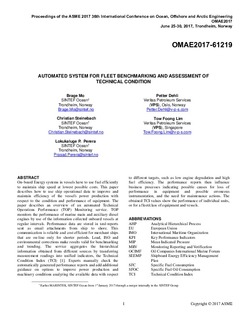| dc.contributor.author | Mo, Brage | |
| dc.contributor.author | Steinebach, Christian | |
| dc.contributor.author | Perera, Lokukaluge Prasad | |
| dc.contributor.author | Dehli, Petter | |
| dc.contributor.author | Lim, Tow Foong | |
| dc.date.accessioned | 2017-11-18T20:35:05Z | |
| dc.date.available | 2017-11-18T20:35:05Z | |
| dc.date.created | 2017-11-17T11:06:24Z | |
| dc.date.issued | 2017-06-25 | |
| dc.identifier.citation | ASME 2017 36th International Conference on Ocean, Offshore and Arctic Engineering - Volume 7A: Ocean Engineering | nb_NO |
| dc.identifier.isbn | 978-0-7918-5773-1 | |
| dc.identifier.uri | http://hdl.handle.net/11250/2467033 | |
| dc.description.abstract | On-board Energy systems in vessels have to use fuel efficiently to maintain ship speed at lowest possible costs. This paper describes how to use ship operational data to improve and maintain efficiency of the vessel’s power production with respect to the condition and performance of equipment. The paper describes an overview of an automated Technical Operations Performance (TOP) Monitoring service. TOP monitors the performance of marine main and auxiliary diesel engines by use of the information collected onboard vessels at regular intervals. Performance data are stored in xml-reports sent as email attachments from ship to shore. This communication is reliable and cost efficient for merchant ships that are on-line only for shorter periods. Load, ISO and environmental corrections make results valid for benchmarking and trending. The service aggregates the hierarchical information obtained from different sources by transferring measurement readings into unified indicators, the Technical Condition Index (TCI) [1]. Experts manually check the automatically generated performance reports and add additional guidance on options to improve power production and machinery conditions analyzing the available data with respect to different targets, such as low engine degradation and high fuel efficiency. The performance reports then influence business processes indicating possible causes for loss of performance in equipment and possible erroneous instrumentation, and the need for maintenance actions. The obtained TCI values show the performance of individual units, or for a fleet/class of equipment and vessels. | nb_NO |
| dc.language.iso | eng | nb_NO |
| dc.relation.ispartof | ASME 2017 36th International Conference on Ocean, Offshore and Arctic Engineering - Volume 7A: Ocean Engineering | |
| dc.relation.ispartofseries | ASME Proceedings | Ocean Engineering;OMAE2017-61219 | |
| dc.subject | Machinery | nb_NO |
| dc.subject | Maintenance | nb_NO |
| dc.subject | Fuels | nb_NO |
| dc.subject | Engines | nb_NO |
| dc.subject | Stress | nb_NO |
| dc.subject | Equipment performance | nb_NO |
| dc.subject | Energy / power systems | nb_NO |
| dc.subject | Energy generation | nb_NO |
| dc.subject | Instrumentation | nb_NO |
| dc.subject | Diesel engines | nb_NO |
| dc.title | Automated System for Fleet Benchmarking and Assessment of Technical Condition | nb_NO |
| dc.type | Chapter | nb_NO |
| dc.description.version | acceptedVersion | nb_NO |
| dc.rights.holder | Copyright © 2017 by ASME | nb_NO |
| dc.identifier.doi | 10.1115/OMAE2017-61219 | |
| dc.identifier.cristin | 1515200 | |
| cristin.unitcode | 7566,7,0,0 | |
| cristin.unitcode | 7566,8,0,0 | |
| cristin.unitname | Maritim | |
| cristin.unitname | Ocean Engineering | |
| cristin.ispublished | true | |
| cristin.fulltext | postprint | |
| cristin.qualitycode | 1 | |
